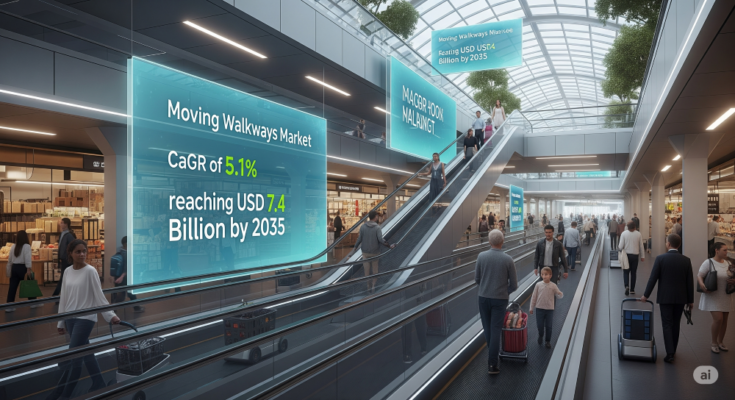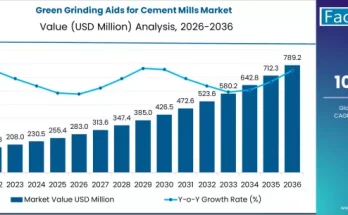Moving walkways, also known as travelators or moving sidewalks, are revolutionizing urban and commercial transportation by enhancing convenience, efficiency, and accessibility. Widely deployed in airports, metro stations, shopping malls, and large commercial complexes, these systems play a critical role in improving pedestrian flow and reducing congestion. The global moving walkways market is witnessing significant growth as modern infrastructure projects, urbanization, and public transportation development continue to rise.
Market Overview
The moving walkways market includes a variety of systems, ranging from horizontal models to inclined designs. Horizontal walkways are commonly used in airports and exhibition centers, providing effortless transport across long corridors. Inclined walkways, meanwhile, connect different floors in multi-level buildings and transit hubs, improving accessibility and comfort.
Modern moving walkways integrate advanced safety features, energy-efficient motors, and automated monitoring systems to ensure reliability and user safety. Manufacturers are focusing on improving speed regulation, handrail synchronization, and surface durability while minimizing maintenance requirements. The market also emphasizes aesthetic appeal, incorporating designs that blend with architectural themes of commercial spaces and transportation hubs.
Regional Insights
The market for moving walkways exhibits regional variations based on urban infrastructure development and public transport initiatives.
- North America leads in adoption due to extensive airport networks, metro systems, and commercial infrastructure. Growing passenger traffic in major airports and urban centers drives the demand for efficient pedestrian transport solutions.
- Europe follows closely, with urban development projects and stringent safety regulations promoting advanced walkway installations. Airports, railway stations, and shopping complexes are increasingly integrating modern moving walkways to enhance passenger experiences.
- Asia-Pacific emerges as a rapidly growing market, fueled by massive urbanization, infrastructure investments, and rising metro and airport expansions in countries like India, China, and Japan.
- Latin America, the Middle East, and Africa are gradually adopting moving walkways, particularly in commercial hubs, airports, and large-scale transportation projects. Growing tourism, retail expansion, and international transit hubs contribute to increasing demand.
Key Trends & Forecast
Several trends are shaping the moving walkways market:
- Integration of Smart Technologies: Modern walkways incorporate sensors, IoT devices, and automated monitoring for predictive maintenance, energy optimization, and real-time passenger flow management.
- Focus on Energy Efficiency: Manufacturers are developing low-energy motors, regenerative braking systems, and eco-friendly designs to reduce operational costs and environmental impact.
- Customization and Design Innovation: Walkways are being customized for aesthetic integration, durability, and user comfort, including slip-resistant surfaces, LED lighting, and ergonomic handrails.
- Expansion in Public Transportation: Airports, metro stations, and railway hubs are increasingly deploying moving walkways to improve commuter convenience and reduce transit times.
- Safety Enhancements: Automatic stop mechanisms, emergency sensors, and advanced handrail synchronization ensure safe operation in high-traffic environments.
Applications & End-Use Outlook
Moving walkways are deployed across multiple end-use sectors:
- Airports: Horizontal and inclined walkways facilitate smooth passenger movement between terminals, gates, and boarding areas.
- Metro & Railway Stations: Walkways provide seamless connectivity between platforms, concourses, and exits, enhancing commuter convenience.
- Shopping Malls & Retail Spaces: Large commercial centers adopt walkways to ease navigation across multi-level complexes, improving shopper experience.
- Exhibition Centers & Theme Parks: Moving walkways support visitor circulation in large-scale venues, ensuring accessibility and reducing fatigue.
- Corporate & Government Complexes: Office campuses and government buildings deploy walkways to enhance mobility for employees and visitors.
The diverse application landscape ensures a steady demand for moving walkways, with urban infrastructure expansion and passenger convenience serving as primary growth drivers.
Competitive Landscape
The moving walkways market is competitive, with key players focusing on product innovation, quality enhancement, and geographic expansion. Leading companies are investing in research and development to deliver energy-efficient, durable, and aesthetically appealing products. Collaboration with infrastructure developers, transport authorities, and commercial real estate companies helps strengthen market presence.
Manufacturers are also leveraging digital platforms and e-commerce channels to expand reach, offering services such as installation, maintenance, and post-sales support. Brand differentiation is achieved through design customization, safety certifications, and innovative technologies that enhance operational efficiency and user satisfaction.
Challenges & Opportunities
Challenges:
- High Initial Investment: Moving walkways require significant capital expenditure for installation, which can limit adoption, particularly in smaller projects.
- Maintenance Requirements: Regular inspections, part replacements, and technical servicing are essential to ensure safe operation, adding to operational costs.
- Competition from Alternative Solutions: Escalators, elevators, and other mobility aids may compete with moving walkways in certain environments.
Opportunities:
- Infrastructure Development: Expanding airports, metro networks, and commercial complexes present opportunities for large-scale walkway installations.
- Smart & Energy-Efficient Walkways: Technological advancements create opportunities for energy savings, predictive maintenance, and enhanced user experience.
- Sustainability Initiatives: Eco-friendly materials and designs appeal to organizations seeking to minimize environmental impact.
- Emerging Markets: Rising urbanization and retail expansion in developing countries offer untapped potential for market growth.
Conclusion
The moving walkways market is poised for robust growth, driven by the need for efficient, convenient, and safe pedestrian mobility in modern urban infrastructure. With increasing integration of smart technologies, energy-efficient designs, and aesthetic customization, walkways are becoming an indispensable component of airports, metro stations, commercial centers, and large public venues.
As cities continue to expand and passenger traffic increases, moving walkways will play a pivotal role in enhancing commuter convenience, improving operational efficiency, and supporting sustainable urban development. Manufacturers and infrastructure planners who prioritize innovation, safety, and environmental responsibility are well-positioned to capitalize on the evolving market dynamics.
The future of moving walkways is closely tied to urbanization, smart infrastructure, and enhanced passenger experiences, ensuring they remain an integral part of modern mobility solutions.



